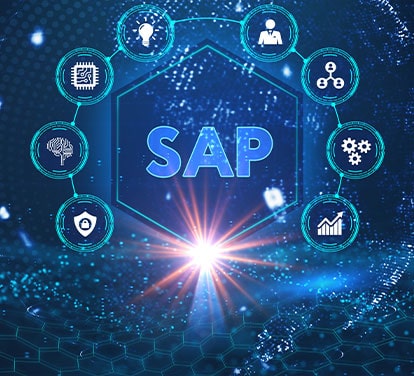Digitizing your procure-to-pay process empowers stronger compliance and control across vendors, contracts, regulations, buyers, and accounts payable.
Enterprises are driven by two fundamental business processes: buying and selling. These pivotal operations encompass the sale of products or services, both of which necessitate the acquisition of various materials and resources.
As a result, the two cornerstone departments of any enterprise are Sales and Procurement. Here’s a series of well-defined steps that initiate the act of procurement and culminate in the final payment. This comprehensive sequence involves procuring the necessary products or services from suppliers or vendors and subsequently fulfilling the financial obligations associated with these transactions.
This integral procedure is commonly referred to as “Procure to Pay” or PTP. SAP, a prominent provider of Enterprise Resource Planning (ERP) solutions, has designed the SAP MM Module (Material Management) specifically to streamline and manage the procure to pay process. While the actual implementation of SAP implementation services may vary based on an enterprise’s unique business model and need, we will be delving into the standardized SAP procure to pay process.
Step 1: Identifying the Requirement
This initial phase involves various departments, such as manufacturing, sales, and administration, meticulously identifying their specific needs and requirements. These requisites are then meticulously documented in what is referred to as a Purchase Requisition (PR). These PRs contain vital information such as detailed descriptions of materials, quantities needed, estimated costs, requested delivery dates, and preferred vendors. These requisitions then undergo a vital approval process, often involving the application of “Release Strategies” within SAP implementation services, to ensure all requisitions align with established guidelines and budgets. The creation of Purchase Orders (PO) is facilitated through the utilization of the ME51N transaction code.
Step 2: Decision of Procurement
Within the Purchasing department, a critical evaluation takes place to determine whether the required materials are already present within the organization’s internal inventory or whether they need to be procured externally from vendors or suppliers.
Step 3: Request for Quotation
The Procurement team initiates the process of gathering quotations from a variety of vendors. SAP consulting services enable the management of these vendor relationships, maintaining a vendor list or source list that indicates which vendor can supply specific materials and the corresponding supply timelines. The creation of Request for Quotation (RFQ) documents is facilitated using the ME41 transaction code.
Step 4: Selection of Quotation
Upon receiving a range of quotations from different vendors, a meticulous evaluation is conducted. This assessment takes into consideration factors such as pricing, product quality, and other pertinent parameters to make an informed selection.
Step 5: Making of Agreement
Following the selection of a suitable vendor, the organization advances to the stage of negotiating and formalizing agreements or contracts. Particularly for long-term commitments, outline agreements are established. These agreements detail terms, conditions, and expectations regarding the material to be supplied by the vendor. The ME31K transaction code is utilized to create these contracts.
Step 6: Purchase Order
The creation of a Purchase Order (PO) marks a critical juncture in the procure to pay process, signifying its utmost importance. Serving as a cornerstone document, the PO is meticulously crafted using the Purchase Requisition (PR) as a point of reference. This facilitates the seamless transfer of essential data from the PR to the PO, streamlining the entire procedure. Emphasizing its significance, the Purchase Order stands as the ultimate document, vital for financial computations and analyses. Executed through the “ME21N” transaction code, the PO’s versatility caters to diverse procure to pay process scenarios.
Distinct categories of Purchase Orders emerge to align with varied procurement strategies. The “Subcontracting PO” pertains to raw materials supplied to vendors, who then transform them into finished goods, encompassing primarily service charges. “Consignment PO” involves vendors storing materials within the purchasing organization’s warehouse, with payment linked to material consumption.
A “Stock Transfer Order (STO)” replicates an internal Purchase Order, enabling procurement from an organization’s subsidiaries or plants. Finally, the “Service PO” facilitates service-based procure to pay process from vendors. Following the PO’s generation, suppliers acknowledge the order, a process integrated with procurement operations, and further streamlined by Enterprise Resource Planning (ERP) systems for remote order acknowledgment. The Purchase Order is undoubtedly a linchpin that bridges requisition and acquisition, playing a central role in effective supply chain management and accurate financial tracking.
Step 7: Advance Shipping Notice
In certain operational contexts, companies follow the practice of sending an Advance Shipping Notice. This proactive notification is dispatched by the supplier to the procurement department the moment the materials are dispatched for delivery. The notice typically includes key details such as the shipping date, carrier details, airway bill number, package count, package weight, delivery address, and a description of the shipped goods.
Step 8: Goods Receipt
In the procure to pay process, the Goods Receipt stage plays a very important role. As goods arrive at the warehouse, the receiving staff generates the Goods Receipt document. During this stage, a meticulous examination of the received material occurs, encompassing checks for quantity, quality, alignment with the Purchase Order (PO) number, and acknowledgment. In the event of any inconsistencies, vendors are promptly informed. The transaction code “MIGO” is employed to create Goods Receipts.
Notably, SAP employs distinct movement types to accommodate varying material flows. Key movement types include 101 for Goods Receiving, 102 for Goods Reversal, 104 for sending blocked stock back to the vendor, and 501 for Goods Receipt associated with inbound deliveries. Additionally, movement type 124 corresponds to credit memos linked to purchase orders. This step ensures meticulous material verification and accurate inventory management within SAP implementation services framework.
Step 9: Invoice Verification
Invoice verification, facilitated by the MIRO transaction in SAP MM, involves meticulously comparing vendor invoices with Purchase Orders (POs) and Goods Receipts (GRs) to ensure accuracy. The process is streamlined by automatic referencing of relevant data, reducing errors. Credit memos reflect vendor credits, debit memos address additional payments, and subsequent adjustments modify invoice totals.
Discrepancies can lead to invoice cancellations, achieved by reversing the invoice document and adjusting accounts payable, promoting precise financial accounting and transparent vendor interactions within SAP MM.
Step 10: Payment
The final step involves the settlement of payments to the vendor. However, before proceeding with payment, it is imperative that both Goods Receipt (GR) and invoice documents are present within the system. This ensures accuracy and accountability in financial transactions. The transaction code F110 within SAP is employed to initiate payments.
Conclusion
While individual companies may incorporate specific variations based on their operational nuances, the core process remains consistent across industries. SAP’s comprehensive suite of solutions aids in effectively managing each step, fostering efficiency and transparency. The integration of SAP with other ERP applications, often customized to suit specific business requirements, further enhances operational effectiveness. This article is primarily dedicated to presenting the standardized SAP PTP process, showcasing the robustness and versatility of SAP’s solutions.
Jade is your trusted SAP consulting partner, offering a blend of SAP expertise and business process solutions to help you achieve Intelligent Enterprise status. Our comprehensive SAP Services fast-track your transformation journey. Check out more about our SAP services.













